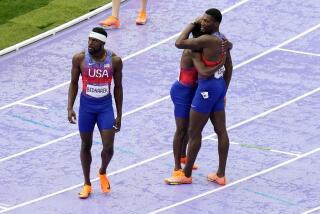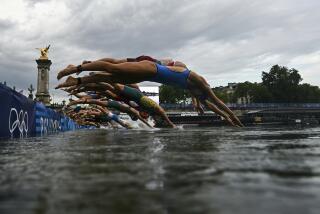Lugers Take Crash Course
- Share via
CESANA PARIOL, Italy — A day after completion of the luge, there were varied reactions to an Olympic competition that left numerous racers sprawled across the narrow, twisting ice chute.
Six sliders -- including three medal contenders -- were knocked out of women’s sliding Tuesday. Two were taken away in ambulances.
Wednesday, in the men’s doubles, there were three more crashes, one by the U.S. duo of Mark Grimmette and Brian Martin, silver medalists in the 2002 Salt Lake City Games.
“I was getting angry,” said Fred Zimny, the U.S. team manager. “Sled after sled having these crashes.”
Still, not everyone had bad things to say about the facility.
“There are two ways to look at it,” said Walter Corey, coach of the Canadian team. “This is a race sport. You could look at a lot of World Cups where half the field crashes.”
Action at Cesana Pariol is now expected to calm down. Skeleton riders, who slide headfirst, riding their sleds on their stomachs, began competing Thursday. They do not steer as much as lugers, who slide feet first, riding their sleds on their backs, so are less likely to spin out of control. Bobsleds, which also use the track, are in even less danger because of their size, with only a few inches to spare on either side.
“We’ve had no problems on that track, even when it was first built,” said Tom LaDue, a spokesman for the U.S. Bobsled and Skeleton Federation.
For lugers, the Italian track has been controversial since its debut last February, when it was temporarily closed after a training session that resulted in serious injuries.
Through summer and into fall, it was reconfigured to soften the more difficult sections, but some within the sport still considered it too difficult. Of particular concern were a series of late turns.
“Last year, it was very dangerous,” Tatjana Huefner of Germany told the Associated Press this week. “Now they have modified the track a little bit but it’s still very dangerous.”
Tony Benshoof of the U.S., who finished fourth in the men’s singles, described the stretch in question:
“The sled speeds up about 20 mph. It’s like you’re driving down the road at 70 and you hit black ice. You’re almost thinking, ‘If I don’t touch the steering wheel and keep going, I might get through this.’ ”
Benshoof, a 15-year veteran, suspects the difficulty of this configuration might have proved too much for less-experienced competitors.
In the months before the Games, luge federations from various countries complained that Italian officials were not making the facility available to sliders wishing to gain familiarity with its twists and turns.
“It wasn’t a matter of us trying to find these little nuances to give us an extra hundredth of a second,” said Jon Lundin, a spokesman for USA Luge. “It was safety. We were fearful.”
Wolfgang Harder, a spokesman for the international luge federation, said in an e-mail to The Times that competitors were given sufficient chance to learn the course and that less-experienced sliders from small nations were invited to an additional week of training before the Games.
Another point of contention involved the Italian team, which was given far more training runs than visiting teams. Italian Armin Zoeggeler won the men’s singles title.
“The Italians had the upper edge in terms of experience,” Corey said. “But with the host nation that always happens.”
As for the crashes during the women’s singles, course spokesman Miccolo Cateni blamed cold weather that dropped the temperature of the ice to minus-14 degrees that day.
“When it’s cold, it is very difficult and quick,” he said. “We had injuries but, fortunately, we didn’t have anything serious.”
Even some who worried about this Olympic competition expect that as sliders become more accustomed to this course, it will gain a reputation as one of the best in the world.
“This is going to be a great track,” Lundin of USA Luge said. “A challenging, difficult, technically demanding track with super speed.”
In the meantime, Benshoof, who was thrown off his sled in practice, figured that crashes were bound to occur.
“That’s the name of the game,” he said. “This isn’t checkers.”
More to Read
Go beyond the scoreboard
Get the latest on L.A.'s teams in the daily Sports Report newsletter.
You may occasionally receive promotional content from the Los Angeles Times.







